
The Friends of the Wildflower Garden
P. O. Box 3793
Minneapolis MN 55403
Ken Avery (1925 - 1997)
Gardener at Eloise Butler Wildflower Garden 1959 -1986
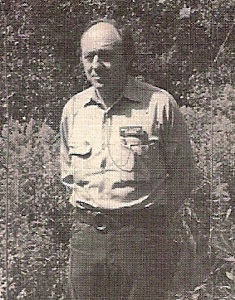
After the first 52 years of existence of the Eloise Butler Wildflower Garden, Ken Avery would be only the third person to be its daily guardian and protector. The first Curator was Eloise Butler herself, who served from 1911 until her death in April 1933. Succeeding her was Martha Crone, who had been Eloise’s occasional helper and plant finder and then served as Curator until her retirement in 1959. That year, a young man of 33 named Kenneth E. Avery began what would be the longest tenure as Curator/gardener of the Garden. Five years earlier (in 1954), Ken moved to Minnesota and joined the Minneapolis Park Board staff as an assistant to Martha Crone. In the spring of 1959, he became Curator, a position he would hold until his retirement 28 years later, although the title "curator" would, by 1965, be replaced with the title "gardener," which more conveniently fit into the Board of Park Commissioners hierarchy at the time. [The official name of the governing body for the park system was changed in 1969/70 to the Minneapolis Park and Recreation Board - both entities are hereafter referred to as the "Park Board"].
Ken Avery had a deep reverence for nature and considered working in the Garden a “very humbling experience.” He considered the Garden a real sanctuary for nature, where “a dead tree is as important to the ecological nature of the area as a live one.” As he worked to preserve the ecology of the Garden, he tried to interfere with nature as little as possible. “Wild plants have an integrity that we must respect” he said. Long before the current interest in native plants, Ken emphasized the preservation and protection of native plants. “If you find something common to Minnesota growing wild, then I say leave it there. Make that area a preserve.”
Below: Ken Avery was the only Garden Curator who had the experience of using both the old "Office" and the Martha Crone Shelter which was completed in 1970. The old office was constructed in 1915 by Park Board carpenters after a design of Eloise Butler. Old office photo from a Kodachrome by Martha Crone, dated June 24, 1948.

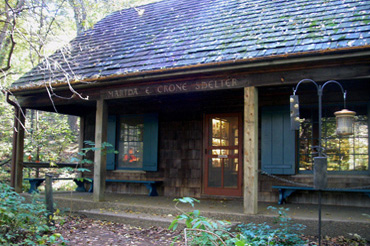
As the new man in charge of the Garden in 1959, Ken Avery was highlighted in the Minneapolis Star newspaper's column "Town Toppers." (pdf). A frequent reader of that column was then U. S. Senator from Minnesota Hubert Humphrey and Senator Humphrey sent Ken a letter in reference to the column (image at right and pdf).

By his own description, Ken was a “backwoods farmer” who did everything in the Garden from guiding tours to transplanting wildflowers to mending bidges and fences to answering the telephone in the Martha Crone Shelter. He meticulously documented the blooming times of plants and flowers. As an example his records indicate that in 1977, for the first time in his (then) 23 years at the Garden the Showy Lady’s-slipper opened in May! (Ref. 26) A lifelong student of nature, Ken wore a small magnifying glass on a leather strap around his neck “For close inspection in case I see something I don’t recognize and want to examine it closely.”
Ken also carried binoculars so he could observe birds “because they’re here.” He said, “I may hear a song and stop what I’m doing and try to identify the bird.” At first Ken was not entirely familiar with Minnesota birds as he was not a native of the state.
He wrote in his annual report to the Park Commissioners for 1961 (Ref. 19) that “These birds are just as important to the Garden as are the flowers since at least as much interest is shown in them as in the flowers.” He further noted in his annual report that “In light of this, I have enrolled in a course in Minnesota Birds at the University of Minnesota to increase my competence in this field.” In addition, the Minneapolis Woman's Club had awarded him a 2-week fellowship to the Audubon Camp in 1960, running August 8 to the 22nd.
As he learned to appreciate all the birds, he kept notes of the arrival dates of the migrating birds. Later he compiled a list of earliest, latest and average arrival date of 21 birds. (PDF copy of hand-written list)
In the "off season" when the Garden was closed Ken's duties in the Garden would be smaller, such as filling bird feeders and removing dead or diseased trees such as those suffering from Dutch Elm disease which was rampant during his tenure, and then he would move to the Park Board Greenhouses seeding plants for the coming season, or perhaps there would be some "one-off" job such as counting and cataloging all the trees in Minneapolis which was a task in the winter of 1975. (Ref. 9a)
Ken was the first to use the restorative process of burning the prairie areas in the early spring before plant growth began, in order to remove thatch and unwanted woody species. He was the first to use a wood chip mulch on the trails to prevent erosion and improve walking conditions.
Ken Avery was a long-time member of The Friends of Wildflower Garden, joining in 1961, contributing to The Fringed Gentian™, serving on the Board of Directors and serving as President 1966 - 1968.
Ken's philosophy of maintaining the Garden was best expressed in this statement: "In regular gardens it is desirable that it appears that man has been there and done his work. In our Wildflower Garden the ideal is that it appears that the present viewer is the first person to see the area." (October 12, 1976, letter of Ken Avery to Gordon Morrison, Coordinator of Environmental Ed at Minneapolis Park and Recreation Board).
A progression of experiences as Gardener
Mucking in the Bog.
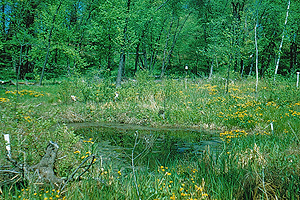
As a result of the dryness that could seriously affect the wetland area in certain years, particularly the 1930s, former Curator Martha Crone had three new open pools dug out in 1946/47 to store water and support aquatic plants. That made four pools in total within what is considered the space of the Garden today, the fourth being the original pool that was created by Eloise Butler right after the Garden was set aside as a native plant reserve. The larger Mallard Pool that was located in the North Meadow had been abandoned in 1944. Details of that in this article.
In 1948 Martha had the three new pools enlarged for more plants. These pools subsequently silted in and had to excavated several times. Ken Avery and assistant Ed Bruckelmyer (retired 1970, photo below) did the first excavation in 1961, removing swamp grass and digging out to a depth of 18 inches. The pools were not connected and if rainfall was not sufficient, the pools would be filled with a hose run from the city water supply in the Upland Garden, one pool at a time. So when Ken and Ed dug out the pools they created a channel from one to the other so that filling one would cause the others to fill also. By 1965 the pools were only 6" deep so Ken dug them out again, this time to a depth of two feet. (18, 23)

By 1979 the pool channel was silted in and had to be dug out once more. After that silting was allowed to run it's course and the pools eventually filled in. The water channel that drains the wetland has been attended to however in later years and kept open. (Wetland History)
Here is Ken's story about doing the 1979 work: "This year (after only 20 years) the little channel was plugged so we had to clean it out too. If you could see me doing it you would wonder if you had slipped back into a past century. You would see me waist deep in water and mud (I do wear waders) dipping the gook out with a 5 gallon paint pail which has been bored full of holes. -- It looks like something out of the digging of the Erie Canal. It's hard work. I don't think you could hire a man to do it today, but it seems to me to be the only way to do the job that won't produce more scars than it heals. It keeps me young -- or whatever I am." (14b)
A Squirrel Story

Only Ken could tell this story properly: “A young man walked into the Martha Crone Shelter with a young squirrel on his shoulder. He said that he had met it up the path and that it had climbed up on its perch on his shoulder. It jumped onto the counter in the shelter, examined everything, upset my coffee, climbed down the door and up my leg, jumped to the desk, back to the counter, and accepted a few sun flower seeds. Later that afternoon, the Batcheors (a couple who bird in the Garden often) were in and the squirrel tried to adopt them. It followed them in a complete circle of the lower garden, over to a little pond outside the fence, and back again. The only way they could get home without it was for me to lock it up in the office while they went to their car.”
"The next day a girl from the Animal Rescue League came over with six little squirrels to release in our Sanctuary but I convinced her that they were still too small to be left there on their own. Before she could leave, “the squirrel" crawled in with the six little squirrels and stole half of their food. Well, five weeks later it is still here,-- the tamest squirrel I have ever seen in my life! I (and you) can actually pick her up- something that is usually even difficult to do to a squirrel that is being kept as a pet in someone's home."
"The girl from the Animal Rescue League has since released her brood too and while they weren't nearly as tame as the first one, they have learned from it that a little friendliness to the public pays off in goodies. Even some of the wild adult squirrels have decided to get in on the game. We are also overrun with chipmunks this year and the whole circus is a delight to the children and parents who come to the Garden. Oh yes, the flowers have been nice this spring too!”
Later in the year he could report: "The squirrel is adult now ... once in a while as I'm walking along a path a squirrel stops whatever busy business is occupying its time as if shocked by the sudden recognition of an old friend and then follows me up to the Shelter for a handful of those most delicious peanuts and sunflower seeds. There are always a number of days between these chance meetings and each time I wonder if it has been the last. Perhaps our encounter as I closed the Garden tonight was it. Who knows?" (4a, 4b)
Late Mail
In his report to the Board of Park Commissioners dated March 12, 1965, Ken requests that a mailbox for the Garden be placed on the corner of Glenwood and Glenwood Parkway (now Theodore Wirth Parkway). In those days mail was addressed to the Garden but since it did not have a postal street address, it was usually delivered someplace close - such as the Wirth Park Chalet where it was frequently delayed or lost. Ken noted:
“Last spring when one of my assistants was golfing he visited the Chalet at Wirth Golf Course and while he was there one of the attendants remembered that some mail addressed to the Garden had been delivered there at the Chalet. He looked through the desk and found what he hoped was all of it. Some of it had been delivered a couple of months earlier and required answers. Then about a month ago my assistant again visited the Chalet and again they remembered that they had some mail for us. One of the letters was mailed last spring requesting information on the possibility of a conducted tour of the Garden last June. Needless to say the only answer I could send now was one of apology." (20) He went on to conclude that future incidents would only lead to a very poor public image. The Garden never did get a mail box to this day.
Plant Experimentation
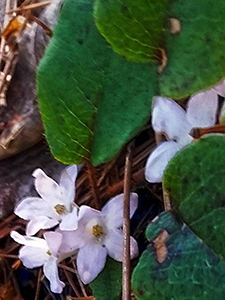
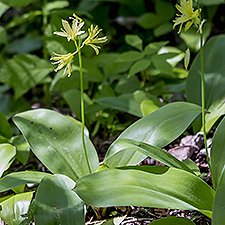
Over the 100+ years of the Garden’s existence, a number of plants that were not originally native to the site have been brought in to create an established colony. Ken had his successes and failures, but he did not attempt to bring in plants that were not native to the state. Several plants native to the state no longer extant in the Garden are worth mentioning:
Bluebead, (Clintonia borealis - photo above), was a difficult one. It is native to the state in the NE quadrant, all the way down to the metro area but not including Hennepin county. Ken reported in 1966 that it was finally established after many failures and was spreading nicely. Eloise Butler has planted it as early as 1907 and replanted a number of years thereafter. Martha Crone first began planting it in 1934 and it was still present when she made her 1951 plant census. And then it was gone again. (2a)
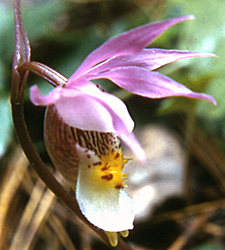
Also being tried once again was Trailing Arbutus (Epigaea repens - photo above), which Martha Crone tried to introduce many times, first in 1933. The last plants had been eliminated some years ago by mice. Also in the category of exotic introductions and re-introductions was Fairy Slipper Orchid (Calypso Bulbosa photo at left), Adam & Eve orchid (Puttyroot) (Aplectrum hyemale) - photo below right) and Cranefly orchid (Tipularia unifolia). Fairy Slipper Orchid was brought in by Martha Crone in 1935 and ‘36. Adam & Eve was introduced by Eloise Butler each year between 1907 and 1910. Martha Crone brought it in during 1933, ‘35 & ‘36. By 1980 Ken would state in later years that this experimentation was no longer the Garden’s mission (see "Reflection" section below). More details of Eloise Butler's and Martha Crone's plantings are found in the Garden History archive for each of those years.
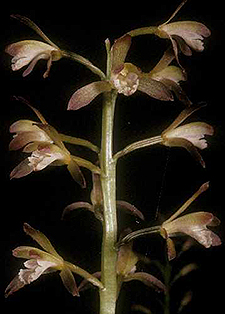
Mosquitoes
Ken Wrote: “Ten years ago the mosquitoes were so bad through the summer that only the most dedicated nature lover would come into the garden at that time. Since then we have obtained a small mist blower and have solved the mosquito problem thus making the Garden a much pleasanter place to visit and our attendance has skyrocketed.” [The mist blower was obtained with funds provided by The Friends of the Wildflower Garden.] (18)
Mosquitoes were always a problem in the Garden. Imagine what circumstances Eloise Butler worked in. Martha Crone had similar problems. Back in 1933, Theodore Wirth had paid a visit to the Garden on the occasion of the Last Rites Ceremony for Eloise Butler and evidently had written a comment to Martha about the Mosquitoes. She replied “I wish to offer my apologies for the ill manners of my mosquitoes, they are rather difficult to train as each one lives only a short time.” (Ref. 24) The Friends provided certain funds to obtain items she needed in the Garden, such as the mosquito sprayer, but until Ken Avery got the mist blower we don’t know how effective the hand sprayer was. In Ken’s day DDT was available and was the insecticide of choice at the time.
Visitors and attendance counts

Martha Crone, beginning in 1946, and Ken Avery would report the estimated number of Garden visitors to the Board of Park Commissioners. We do not know the accuracy of these numbers as they were estimates by the person in charge and there was no ticker to record each opening of the Garden gate. What is important, is that even if the numbers are grossly exaggerated, the visitor count in those days was quite significant. Examples of Ken Avery’s estimate of Garden visitors:
1961 - 100,000
1962 - 100,000
1963 - 110,000
1964 - 150,000
1965 - 150,000
1969 - 160,000
In 1965 he reported that 2,000 people in 95 organized groups visited for conducted tours. (23) The number of tours is significant as it would only increase in the next decade.
Martha Crone’s activities, while still Curator, had set the stage for people wanting to visit the Garden. She was an endless promoter of the Garden. In 1950 she introduced the first free Garden Brochures; in 1951 she produced a Garden History and in 1952 she introduced her Self-Conducted Tour brochure. She references the success of these in several reports (10,000 distributed in 1952) and in 1953 there was also available a Garden plant list, which included the 1951 history, which were sold for 10 cents each to visitors. She did radio and newspaper interviews. Also in 1948, Martha began to put together a set of color slides of Garden plants that she could use for illustrated lectures about the Garden. She began to give talks in 1951. In 1952 and 1953 alone she give 53 lectures about the Garden to a total of 3,118 people. She would occasionally write of the burden on the Curator of handling all the groups that wanted tours.

Ken Avery could have complained likewise, but he only reported the facts. He reports in Summer 1967: “110 groups visited the Garden with the greatest number being grade school, 3rd grade and up. The rest were Brownies, Bluebirds, Scouts, Garden Clubs, Kindergarten Classes, High School and College Classes.” (3)
Summer 1969: As of June 10th: “Seven buses of school children at one time in the parking lot everyday from May 1st until this past week when they averaged 4 or 5 per day - at least 35% underprivileged.”(3)
In 1971 he writes of phenomenal growth in attendance - “capacity crowds on Sundays.” “The Garden was overwhelmed in the Spring.” In 1970 a guest book was started at the new Martha Crone Visitors Shelter, a gift of Dr. Marion Grimes, who became in 1971 the Friends' coordinator of volunteers for staffing the shelter - a position and volunteer group that had been started the previous year. It already had 3,500 signatures. (2b)
These years were the heyday of Garden visitations, however in Ken's first years as Gardener he sometimes felt lonely in the Garden. He would later tell Jo Ann Rice "I'd hear the gate clank open and would practically run out to shake the visitor's hand." (Golden Valley Sun June 7, 1972). That was obviously not during the later times of heavy tours.
Cars and paved roads
One reason attendance could increase at a great rate in the 1950s and 1960s was the ability of most people to buy a car for transportation following the expansion of the national economy after World War II. Public transportation still existed to the Garden, it just changed mode. It was in the early 1950s that city buses replaced the street-cars for public transportation and the buses stopped close to the Garden as did the old street-cars. The old street-car line terminus was on Glenwood Avenue opposite what is now Wirth beach. The expansion of personal transportation required more paving of roads. In the early years of his tenure, the road to the Garden south entrance and the parking lot at the garden had never been paved and Ken once reflected that before they were paved Warren Cadillac used to try out its cars on the road. If they didn’t rattle there they wouldn’t rattle anywhere. (12)
Experiments
Experiments: The Use of Fire
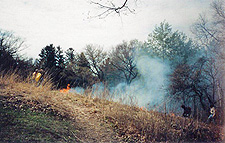
In 1965 Ken began the practice of burning off dead plant material from the prairie area. Previously he would cut it. Friends member Phoebe Waugh remembers visiting the Garden in the early 1960s with her young daughter and talking to Ken and she remembers a "hot" prairie with the mowed grass. Burning would also prevent the growth and encroachment of trees and shrubs where they were not wanted. It also ushered in the more natural arrangement of native plants. Phoebe's life took her away from the Garden until 1996 and she was amazed at the changes that had occurred in the Prairie Garden once mowing ceased. This practice of burning has continued to the present day, although not with the frequency of earlier times. (23) Photo at right: A spring prairie burn in progress.
While the burns effectively removed dead plant material buildup, they did not control the toughest shrubs such as sumac and oak. Ken tried with some success to poison them by cutting the bark and dabbing poison on the cuts; successful, but it produced unsightly dying shrubs. His opinion is expressed in this statement:
"First, I should explain that those shrubs are some of the most persistent “weeds” we have in the Garden. We have cut them, burned them, and torn them out by the roots, but in an area as large as ours it has been impossible to eliminate them. The truth is that there are still just as many as there were ten years ago. Burning, one of the techniques I just mentioned, is now the darling of those who would manipulate ecosystems. It is prescribed for maintaining forests and it is said that you cannot have a prairie without fire. Many seem to think that fire is a magic word and you have only to burn an area and, presto! you have a prairie. I will agree that fire is an important tool in maintaining prairies but my experience is that fire alone will not do the job. Fire seems particularly ineffective in controlling sumac and oaks -- two of our greatest problems in the garden." (6a)
 The use of fire near the wetland area presented its own problems as there is an underlying layer of peat. It was a practice of burning the larger accumulations of wood removed during the winter. In the 1970s dead elm wood was the main debris removed. Ken and his helpers had to be very careful where they burned it - he had put out many peat fires in the past. In November of 1976 someone had started a fire in the Garden and the peat caught fire. Ken had to call in five extra men to help dig it out. (10) This is still a concern today. Cary George was burning brush piles in November 1989 at the edge of the wetland and started a peat fire which took some effort to put out. (17b). Photo: Current Garden Curator Susan Wilkins burning Buckthorn cuttings in the spring in the wetland area.
The use of fire near the wetland area presented its own problems as there is an underlying layer of peat. It was a practice of burning the larger accumulations of wood removed during the winter. In the 1970s dead elm wood was the main debris removed. Ken and his helpers had to be very careful where they burned it - he had put out many peat fires in the past. In November of 1976 someone had started a fire in the Garden and the peat caught fire. Ken had to call in five extra men to help dig it out. (10) This is still a concern today. Cary George was burning brush piles in November 1989 at the edge of the wetland and started a peat fire which took some effort to put out. (17b). Photo: Current Garden Curator Susan Wilkins burning Buckthorn cuttings in the spring in the wetland area.
Experiments: Path mulches.

Eloise Butler did not mulch the paths as they were not as wide in her day, nor did she have large groups walking them. Later, Martha Crone used pea-sized gravel (photo right). Ken Avery, would speak of the laborious task of hauling the gravel back up the hills after a rain washed it downhill. Gardener Cary George would report finding pockets of it some 40 years later. Ken would also say that in dry weather the gravel would roll down the hill and be just as dangerous as mud, so he tried wood chips, particularly elm (which were plentiful when Dutch Elm disease was felling many elms). The advantage of wood chips was that they were organic, light, and would feel softer underfoot and in the wet areas would prevent the formation of mud and furthermore “its appearance is in harmony with the Garden providing beauty as well as utility." (Ref. 18) He began using chips in 1960. [Years later Cary George found cedar shavings to be the best compromise.]
Experiments: Creating a Sphagnum Bog
The wetland community hosted a number of unusual plants which, when located near a path, would frequently be stolen. One of Ken’s ideas was to create a floating sphagnum bog that could be anchored in the water away from the path. He created a raft made of chicken wire and buoyed up by wine bottles that had replaceable caps - “Those of the cheap wines which appears to be preferred by park drinkers.” The moss was lifted from the old bog (meaning the quaking bog across Wirth Parkway from the Garden) and tied to the chicken wire. The wine bottles came from the daily parking lot clean-up. There are no later reports on how long this thing lasted.(13)
Experiments: Orchids
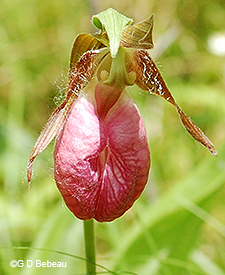
While a certain number of orchids are native to the Garden site, only two exist in the Garden today: The Showy Lady’s-slipper (Cypripedium reginae) and the Yellow Lady’s-slipper (Cypripedium parviflorum var. pubescens). Martha Crone was particularly partial to orchids. Her 1951 census lists 25 in the orchis family as present in the Garden. Many would die out - frequently due to the difficulty in transplanting these species. Ken liked them also and would attempt to reestablish certain of the species. Mentioned above in the section on plant experimentation were Fairy Slipper Orchid (Calypso Bulbosa), Adam & Eve orchid (Puttyroot) (Aplectrum hyemale) and Cranefly orchid (Tipularia unifolia).

In 1973 he was introduced to a Mr. Kingsbury who had a garden north of Bemidji, MN with many Pink stemless lady-slippers - Moccasin Flower, (Cypripedium acaule) (photo left) and Ramshead Lady-slippers (Cypripedium arietinum) (photo below in section on vandalism) growing with ease and success. Ken was invited to up in the spring of 1974 to see where they came from. He is taken to the spot and Ken secures, in his words, “a sufficient number for the Garden.” The woods where they grew was scheduled for cutting, otherwise Ken would not have disturbed them. (6)
A similar venture was the gathering of Large Twayblades (Liparis liliifolia). Cary George reported that Ken had discovered a large patch near old Highway 12, which was being transformed in a few years into I-394. They did not transplant well and did not survive. Martha Crone had little success either. (17c) Cary George would try to reestablish these from the same source in 1991 but they did not transplant well and were not thought to have survived until in 2022 a Garden field crew of Elise Jacobson, Louisa Brody, and Nicholas Purcell stumbled across a patch of them while pulling Leafy Spurge in the Upland Garden.
Completion of the Fern Garden
 In 1955 the Friends of the Wildflower Garden received a gift of funds from the Minnetonka Garden Club and the Little Minnetonka Garden Flower Club to create a fern hill in an undeveloped part of the Garden. Martha Crone began this project in 1956 by setting out 2,160 fern plants followed by 308 the next year and ending her work on the project in 1958 when the total reached 2,843 fern plants. Ken Avery added an additional 250 ferns in 1960 and '61 and Martha Crone could report in 1963 in the Fringed Gentian™ that the Fern Hill was reaching a stage of “fine development.” (1)
In 1955 the Friends of the Wildflower Garden received a gift of funds from the Minnetonka Garden Club and the Little Minnetonka Garden Flower Club to create a fern hill in an undeveloped part of the Garden. Martha Crone began this project in 1956 by setting out 2,160 fern plants followed by 308 the next year and ending her work on the project in 1958 when the total reached 2,843 fern plants. Ken Avery added an additional 250 ferns in 1960 and '61 and Martha Crone could report in 1963 in the Fringed Gentian™ that the Fern Hill was reaching a stage of “fine development.” (1)
To winter-protect the fragile young ferns Ken had the area heavily covered with oak leaves in the fall of 1963. The leaves would serve as mulch in the coming years. Moth crystals were spread to discourage the mice. Today, the area has filled in with other plants and larger trees but still has a number of ferns. [The full story of the Fern Glen]
Photo above: The Fern Garden, in the process of being planted, May 14, 1956. Photo from a Kodachrome by Martha Crone.
Troubles - Undesirables
Eloise Butler noted her troubles with muskrats, a hog, and certainly people not respecting what she was trying to save. Martha Crone was even robbed once in the Garden. Over the 28 years of his tenure as Gardener, Ken Avery recorded some of his troubles. The first was linked to the Park Commissioners placing the wild area around the Garden under the supervision of the Eloise Butler Gardener. This happened in 1964 and the area quadrupled the space for the Gardener to take care of (Ken had assistants at this time - he was to lose them in later years.) His main problem was twofold - the parking lot at the bottom of the entry hill to the Garden (the purpose of which was to serve the Great Medicine Spring) and motorcycles. Ken explains it best:
The lot “will only hold two or three cars but is rather secluded and a high percentage of those using it seem to be “undesirables”--we remove more beer cans, wine bottles, etc. from this area then we do from our larger parking lot.” He then requested that the area be closed to parking. [Note: This problem would not go away until the lot was actually closed in the mid-2000s]. (22)
“The second and more urgent problem is that of motorcycles on the foot paths in the area. I am sure that on some of the nicer Sundays last spring as many as 50 would race through the park. They would go through in packs of a dozen or more scaring any living thing in their proximity and driving all peace and quiet out before them. I feel that if something isn’t done soon they will make the park of little use to anyone who isn’t on a motorcycle.” He offered some suggestions such as placing posts with cables between to prevent them from leaving the paved roads. (22)
He repeated his request the following year and added “these pests are getting worse each year and will destroy the area if something isn’t done soon.”(23)
Skiing and vandalism:

In 1973 Ken noted that when he went to the Garden to fill the winter bird feeders he would find people arriving by car to use the hills for skiing. He first noticed this about 1965 - a few people started discovering that the park was beautiful in winter and with the rise of cross-country skiing, the winter seclusion of the park vanished. This popularity also brought vandalism. (5)
In 1973 alone there were three break-ins to the Garden. The last one, in May, was into the Martha Crone Shelter where the tape deck was stolen. The deck had been a memorial gift of the Shelter architect, Mr. Hiram Livingston. In an earlier break-in nothing was taken. The third break-in was to the tool shed where the chain saw was taken. (5) In 1975 Ramshead Lady’s-slippers (photo below right) and Maidenhair Ferns were taken. (8) In 1986 there was a break-in to the Martha Crone Shelter during the first week of April. Glass was broken in the exhibits, several books were destroyed, some furniture damaged and the front door was broken. (16)
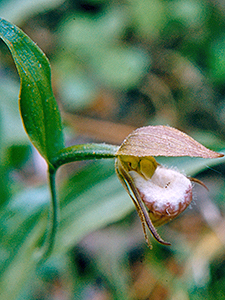
He was not completely against using the park in winter for recreational purposes. He mentioned in his 1963 report to the Board of Park Commissioners that the road from the parkway to the Garden parking lot had been closed (for the first time apparently) and that subsequently it found a new use as a “safe, convenient hill for sliding. The general area has also seen an increase in its winter use as a hiking and skiing area plus, of course, its continued use as an area to observe nature. I might add the only one in Minneapolis easily accessible by public transportation.” (21)
Years later the increased use was to bother him. By 1979 he reported that there was no need to blaze a trail to a work area - the trails were all packed down and only the Garden and remote areas of the park were untrod. Wildlife that used to have the whole park now had just the Garden as a sanctuary. (14)
While Ken’s philosophy was that the wild areas should be kept wild, the use of Wirth Park for recreational skiing and later for competitive skiing was not going to go away. When it occurs in the buffer zone around the Garden it has been a contentious issue for the Friends and the Park Board ever since.
Dutch Elm Disease

Photo Above: Ken with Garden Naturalist - May 16, 1981. Photos courtesy Lynne Holman
Ken’s first notation in his reports about the disease occurs in the 1964 Report to the Board of Park Commissioners dated March 12, 1965 when he mentions that he had the help of a tree trimming crew to remove dead and dying elm wood. He then states that he believed he made an important finding as to the sanitation of diseased wood. He found that it took only one fourth of time to debark a tree as it did to cut it up. Because there were so many large large elms in the wetland area of the Garden and just outside the Garden, removal would be difficult and this might be an important remedy to control the disease. [Note: it had been established by arborists that removing the bark from dead elm wood was sufficient to prevent the spread of the disease, so Ken’s remedy was on the mark.]
The progress of the disease was to last for many years. In 1975 Ken noted that the Park Board was removing diseased elms from the swamp area behind the Garden and that three trees had been removed within the Garden in 1974. (7) In 1976 half of the remaining elms in the Garden died during the summer. Friends president Alexander Dean also noted that the loss of tree canopy in the Woodland Garden, causing the growth of brush, vines and heavy weeds, would require re-planting of trees. (9b) Beginning in the fall of 1977, small trees were being planted to replace elm losses (photo above and below). (11) This process continued for years during his tenure as Gardener. The scourge began in 1963 and By 1986 94,988 trees had been removed with 105,012 remaining - all within the City of Minneapolis. Most of those in the Garden were lost by that time although there would be further removals of elm into the 1990s.
Below: A group of The Friends and Garden staff at a tree planting moment ion May 16 1981 celebrating the 30th Anniversary of the founding of The Friends of the Wildflower Garden. From l-to-r: Naomi Loper (MPRB President), Pat Huntington (MPRB public relations head), Friends Board members Marie Demler and Moana Odell Beim, Mary Maguire Lerman (MPRB Coordinator of Horticultural Programs), Unidentified MPRB Naturalist, Unidentified Friends member, Gardener Ken Avery, Friends member Lynne Holman, Friends President O. Lynne Deweese, and Mike Ryan (MPRB Coordinator of Environmental Education).

The Garden Buffer Zone
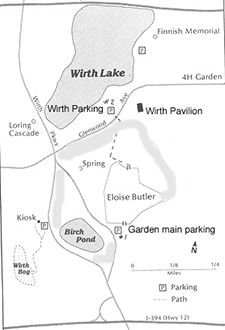
In 1964 the Park Board agreed that the area surrounding the Garden (outside the fence) was to be placed under his control, with a corresponding increase in workload. Ken was in favor of this change. In fact he considered it an important milestone "one rivaling, if not exceeding, in importance that of the addition of the Prairie Garden in 1944." He added - "This quadrupled the area we have to work with and makes it possible to treat the entire area as one integrated unit. We of the Wild Flower Garden are eager to assume this task.....we have always felt that the chief value of this area was for the study and appreciation of nature. Now that the Board has passed the motion dedicating it to this end, we are planning to adjust all maintenance activities toward this goal. It will not require any great change but just that all activities be paced to show greater respect for the ecological relationship of the area and to exploit all of its possibilities as a natural area." (23) Unfortunately, the realities of the budget and other management issues prevented this idea from being carried out. The result of that is that the buffer zone area and the uses made of it would be a source of future contention for those that followed in Ken's footsteps.
Reflection on the status of the Garden

During his tenure, Ken Avery experienced a number of changes in the Garden - some of his own doing of course. He changed the philosophy of what plants should exist in the Garden. He was more focused than Martha Crone on plants that were native to the area - not just to the wider geographic climatic zone.
In 1980 he reflected on several major Garden issues. One issue was in his relationship with the Minneapolis Park and Recreation Board. Martha Crone had the title of Curator, his title is Gardener but the pay and duties were the same. This was somewhat difficult for him as for the first six years he had had the title of Curator. A second issue was his observation that the Garden reflected the personality of the person in charge.
Two subtle changes were necessary in the Garden’s focus:
First, with the opening of the University of Minnesota’s Landscape Arboretum, the interest in the Garden’s testing of the hardiness of exotic pants, which he had done, was not warranted. Concentration should be on reintroducing native plants that had once grown in the area; second, the Garden should be institutionalized to remove the personality of the person in charge. He felt that the building of the Martha Crone Shelter (photo at left) had helped move toward the latter point - with the new large Shelter given to the Park Board by The Friends of the Wildflower Garden, the Park Board seemed to re-discover the Garden and began to assert its influence. Two examples: An environmentalist, Mike Ryan (see group photo above), had been assigned to the Garden and Mike Ryan had a concern for native plants - and that was good. Further, he, members of the Friends, and Mike Ryan were working a new self-conducted Garden Tour Guide, the first since Martha Crone did hers in 1952. (15)
Editorial Notes: Ken's statements about institutionalizing the Garden can be explained in another way. Both Eloise Butler and Martha Crone had freedom to shape the Garden in the manner they chose. The landscape design and the plant selection was their prerogative - limited by their budget and time. They made an annual report to the Park Board of what they had accomplished and that was that. The result of that was a Garden that reflected, in Ken's words, "the personality of the curator." It is fortunate that Eloise Butler had that free opportunity or the Wildflower Garden as we know it might not exist today. But once the focus and plan was in place, the goals and vision of the creator should not be constantly modified by the new person in charge. "Institutionalized" meant keeping to the plan unless there was consensus to change. It meant adhering to a plant selection criteria that was based on a well founded ideal. Ken narrowed that focus down to a Wildflower garden that appeared not to reflect the hand of man, but of a more natural order, and stocked with plants that were native to the area. If the Park Board could oversee that focus, then the ideal of the Garden could be preserved. The organization of the Friends of the Wildflower Garden was founded to preserve and protect that ideal.
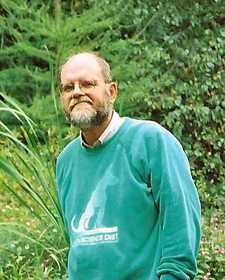
As the years went by Park Board budget cuts were particularly painful to Ken. In the early years of his tenure he had several assistants. Gradually they were all taken away. Robert Clark worked with him from 1955 through 1957, then Ed Bruckelmyer, who had worked with Martha Crone in 1948 and '49 returned in 1958 and worked until he retired in 1970. Following Robert Clark, Sam Baker was around in the early 1960s and then reappeared after Ed Bruckelmyer retired and Sam worked until the end of 1976, at which time Richard Wick came to help as his only helper. By the time he retired he worked alone. Additional help was temporarily available but short term only. He once reflected in a letter to his supervisor that when he had two assistants the Garden was polished like an apple. When one was taken away it was not polished all the time. When the second was taken away it was still an apple but no longer polished. Ken gave an abrupt 3-day notice of retirement at the end of 1986. (17e) Cary George took over as Gardener on January 1, 1987 and he usually worked alone also. (Photo at right: Cary George 2002)
Cary George takes over
All those who knew Ken appreciated his abilities and his dedication to the Garden. It was difficult for him to let go as he wanted to find someone who would carry on his philosophy, although at the same time as noted above, he thought the Garden should not reflect the personality of the person in charge. When Cary George got the job Ken felt that Cary George would “belong there.”
In Ken’s last letter to the membership of the Friends he wrote:
“When I first came into the Garden under Mrs. Crone, I fell in love with what I found there and have never intentionally changed it in any way. Oh, it has changed, nature and society have changed and in so doing have forced some changes, but most of these were just cosmetic. In most ways, it has remained much as it was when I first walked through its front gate. Another reason for leaving at this time is that I can now do so with a clear conscience. Until recently there was no one in the Park system who I felt could take over the Garden. Those of you who have met my replacement, Cary George, know that he is an intelligent person who is interested the Garden and who will husband it very well. I have to admit that my one apprehension in leaving is that he will do such a good job, that this spring might be marked as the end of the dark ages for the Garden.”
Interestingly, Cary George would be quoted years later in Ken Avery's obituary saying something very similar about Ken Avery: "He kind of wore many hats. . .he was the kind of person whom you could look at and know he was in the right job. He was excited every spring of his life, it was such a perfect fit for him, and he loved it. He was the perfect man for the job and for the times." Ken would regularly stop in at the Garden to say hello to Cary and Cary wrote in 1998 "After twelve springs at Eloise Butler Wildflower Garden, this was the first that Ken Avery did not say to me - 'And how is Mr. George today?' I miss his gentle spirit, his love of the Garden, his above-the-fray attitude. He made me a better person. Some losses cannot be replaced. Ken Avery is one of them." (17d) Ken passed away on Nov. 19, 1997 at his home in Minneapolis. (Ken's obituary)
An Active Member of the Friends of the Wildflower Garden

On May 21st, 1966, at the annual meeting, Ken Avery was elected president of The Friends of the Wildflower Garden. It was the first time the annual meeting was held at the Garden and it was on a day of “profuse bloom” as reported. This was before the construction of the Martha Crone Shelter so the meeting would have been in or near the old “Garden Office.” Martha Crone was still the editor of the Friends’ Newsletter The Fringed Gentian™. This was still the era when experimentation of which plants would grow in the Garden environment was taking place as noted above in the section on plants. (26)
Ken was reelected President at the 1967 annual meeting, held again in the Garden on May 20th. Mrs. Clinton Odell (Amy) had passed away on December 7, 1966 and a memorial for her was being planned. 1967 was the first time the Friends began to publish memorials given for the Garden. In the summer Ken was host on a Garden visit of London actors Dame Sybil Thorndike and Lewis Casson who came to the Garden, brought by their daughter Mrs. Douglas Campbell of the Guthrie Theater. A devastating tornado uprooted over 2000 trees in Minneapolis, but the Garden was spared. (26)
At the annual meeting of The Friends on May 18, 1968, the president position was passed on to Cay Faragher. The day was very cold and uncomfortable for the group as they met in the “little cabin.” But the idea of building a new visitors center was begun at this meeting and Cay Faragher would see it through to the completion. Ken remained an active member of the Friends throughout his tenure. As late as 1985 he chaired the nominating committee for board and officer positions. He also generated some Garden publicity via an interview on station KSJN in April, 1985. (26)
Friends' members have recollections of Ken Avery
 Marie Demler became a Shelter volunteer and then volunteer coordinator after Dr. Marion Grimes relinquished the task. She remembers in early April coming down the path and smelling Ken’s roaring fire in the Martha Crone Shelter. Marie and husband Max celebrated their 50th anniversary at the Garden in 1985 and Ken gave a "lovely" talk to the group. (25)
Marie Demler became a Shelter volunteer and then volunteer coordinator after Dr. Marion Grimes relinquished the task. She remembers in early April coming down the path and smelling Ken’s roaring fire in the Martha Crone Shelter. Marie and husband Max celebrated their 50th anniversary at the Garden in 1985 and Ken gave a "lovely" talk to the group. (25)
Florence Isaacs (photo below) remembers her husband George arranging for old street car line bed ties to be available to Ken for path edges in the Garden. (25)

Lynne Holman remembers Ken’s help in producing a self-guided tour booklet for the Garden which, after 5 years of planning, was printed in 1981. There had not been one since Martha Crone did hers in 1952. (25) Photo above: The celebration to "open" the new self-guided tour on May 16th, 1981 included a ribbon cutting at the entrance to the Garden trail. Left to right: Friends' President O. Lynne Deweese, Lynne Holman and MPRB Commissioner Naomi Loper. Photo courtesy Lynne Holman

John Haldeman (photo below, courtesy of the Haldemans) remembers having his wedding scheduled on an October Saturday in 1981 in the Upland Garden but the weather turned cool and rainy and Ken made the Martha Crone Shelter warm and cozy with a roaring fire in the Fireplace, so the ceremony was held there. (25)
Phoebe Waugh remembers coming to the Great Medicine Spring for water and walking through the Woodland with her 2 year old daughter and meeting Ken who talked of the pasque flowers in the prairie area but Phoebe never could find them. (26)
In Summary
A quotation from a Garden Visitor’s note to Ken Avery, received at Christmas Time, 1974, may best end this summary of Ken’s tenure:
“Thank you again for the beautiful day I spent in the Wild Flower Garden. Please let the kind people who had volunteered to keep shop know how much I appreciate their interest and the warm welcome they extended not only to me but to all the individuals and groups who dropped by that day.
It gives one a warm feeling to know that such a spot exists and that it is lovingly tended and used.”
Postmarked from Langhorne Pennsylvania, signed by Eloise M. Riggs, who was named after Eloise Butler who was Miss Riggs’ mother’s favorite cousin. (7) Years later in 1988 Eloise Riggs would meet Martha Hellander in Malden MA when Martha was researching her book on Eloise Butler. Miss Riggs is pictured in this article about the Malden home of Cora Pease.
A memorial: In January of 1998 The Friends board decided to pursue doing something to honor Ken Avery. During the year planning was done for an attempt to establish a "Ken Avery Research Fund" at the University of Minnesota that would support student research in the Department of Horticultural Science. The University estimated that about 5% of a fund could be expended each year for student research.
Friends President Harriet Betzold by late Summer had received a ready to sign agreement from the University but the minimum funding required was $10,000 and the board decided not to pursue it.
The Ken Avery Birding Terrace.
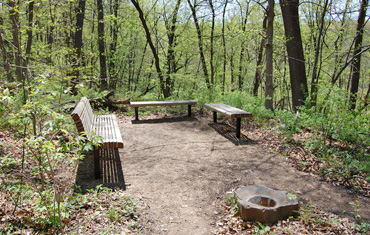
As Ken Avery had become an avid birder during his tenure at the Eloise Butler Wildflower Garden, The Friends of The Wildflower Garden and the Park and Recreation Board decided in 2004 on the creation of a special place for bird watching and, as a honor to Ken and his dedication, named it for him. The Friends would fund the project. There are three wood benches made by Earl F. Anderson Inc.; a basalt column carved bird bath from Hedberg Aggregates and a dedication plaque on the birdbath made by Awards by Hammond, Inc. The surrounding area was planted 350 new shrubs and herbaceous plants. This area is near the back gate on a natural bench of land just off the trail leading to the Upland Garden. It overlooks the wetland and the Hemlock Grove. Native bushes and flowers are planted there. It was dedicated on Father’s Day, June 19th, 2005 at 2 p.m. A large crowd attended. Comments were given by Friends President Steve Pundt; Muriel Avery, Ken’s widow; Cary George, who immediately followed Ken as gardener; Dan Hasty, who had known Ken as a Park Board colleague and mentor; Park Commissioner Vivian Mason; Tammy Mercer, who conducts birding programs at the Garden; and Susan Wilkins, the current Garden Curator.
Below: The terrace is elevated above the wetland area of the Garden, situated half way between the Upland and Woodland Gardens. It's location is at the north end of the Woodland Garden - noted in the center of the map.


Below: The Quiet terrace just off the path between the Upland and Woodland Gardens in mid-summer. An early Saturday morning birding group led by naturalist Tammy Mercer (center with staff) making use of the Avery Birding Terrace

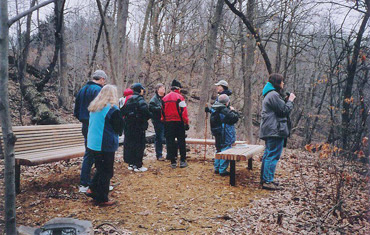


The Dedication Day




Note: The first section of this history incorporates an article written earlier by Friends Member Constance Pepin. Her article was originally published in the Friend's newsletter, The Fringed Gentian™, Winter 2005 Vol. 53 No.1.
Garden Names: In 1929 the Garden was renamed to “Eloise Butler Wild Flower Garden.” “Wild Flower” was used as two separate words until 1969 when it became “Eloise Butler Wild Flower and Bird Sanctuary” which was not satisfactory, and by 1972 Eloise Wildflower Garden and Bird Sanctuary with “wild flower” compressed into one word had come into use and this name was made official in late 1986. In this text both versions are used depending on the time frame.
Reference List:
The Fringed Gentian™ - pdf copies of these issues are found in the newsletter archive
1. October 1963 Vol. 11 #4
2a. October 1966 Vol. 14 #4
2b. July 1971 Vol. 19 #3
3. July 1969 Vol. 17 #3
4a. July 1973 Vol. 21 #3
4b. Oct. 1973 Vol. 21 #4
5. Jan. 1974 Vol. 22 #1
6. July 1974 Vol. 22 #3
6a. October 1974 Vol. 22 #4
7. April 1975 Vol. 23 #2
8. July 1975 Vol. 23 #3
9a. January 1976, Vol. 24 #1
9b. Fall 1976 Vol. 24 #4
10. Winter 1977 Vol. 25 #1
11. Summer 1977 Vol. 25. #3
12. Spring 1978 Vol. 26 #2
13. Summer 1978 Vol. 26 #3
14a. Winter 1979 Vol. 27 #1
14b. Fall 1979, Vol. 27 #4
15. Winter 1980 Vol. 28 #1
16. April 1986 Vol. 34 #1
17a. August 1987 Vol. 35 #3
17b. March 1990 Vol. 38 #1
17c. October 1991 Vol. 39 #3
17d. April 1998 Vol. 46 #1
17e. Memo of Mary Maguire Lerman to the Friends, May 29, 1987
Annual Reports to the Board of Park Commissioners:
18. March 7, 1961 for 1960
19. March 5, 1962 for 1961
20. January 28, 1963 for 1962
21. March 23, 1964 for 1963
22. March 12, 1965 for 1964
23, March 4, 1966 for 1965
24. Letter of Martha Crone to Theodore Wirth, June 22, 1933
25. 50 Years of Friends, published by The Friends of the Wildflower Garden, 2002
26. Ken Avery's tabulation of early and late flowering dates for 25 important spring plants. (pdf file as of 1977)
27. Miscel.
Garden Logs of Eloise Butler and Martha Crone.
Papers and notes in the Martha Crone Collection, Minnesota Historical Society.
Annual Reports and Board Meeting Minutes and Correspondence of the Friends of the Wildflower Garden, Inc.
Photos by Martha Crone are from her collection of Kodachromes that was given to the Friends by her daughter Janet following Martha's death in 1989.